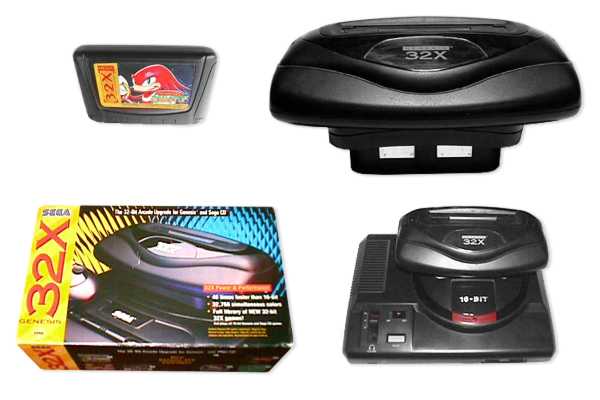
The idea for the 32X originally came from Sega of Japan and was handed to Sega of America to work on. SOA decided that it was better for the unit to be an upgrade to the existing Mega Drive rather than a separate console. This move would have the advantage of making the 32X more appealing to users who would rather upgrade their current hardware then buy an all-new standalone console. SOA went with the SOJ design plan to have twin 32-bit processors and a separate graphics processor. In November 1994, the 32X was released in the US, a month later in Japan (where it was called the Super 32X) and in January 1995 in Europe.
At first, the 32X was a success. Sega was unable to ship the 1 million units it had promised and ended up shipping about half of that to retailers because of slow production. Nevertheless, the 32X sold out in many areas and Genesis owners were keen to get their hands on it in time for Christmas. With a non-existent library of games and none bundled with the unit, consumers who had bought the 32X had to be patient for a while.
Things then started going down hill. Complaints started coming in about the the unit not being compatible with some older TVs, which prompted Sega to release an adaptor to rectify the problem, at a price of course. Another issue was the metallic clips, which had to be placed on both sides of the cartridge slot to protect it from electromagnetic interference. Apparently, many parents found it difficult to clip them on around the cartridge covers. I can't seem to believe that this was a major problem, but then again what do I know except for what I read.
A third factor was news coming in from Sega of Japan about the Saturn, which left gamers confused. Was the 32X the thing to have, or was it the Saturn, or maybe the Sega CD! Unsatisfied customers took back their 32X hardware and software to their stores and the 32X seemed to be in big trouble. Upcoming games were slowly cancelled and both Sega and retailers across the US realized that the 32X didn't have long to live. By the Christmas of 1995, the 32-bit console was dead and buried, with DarXide being the last game ever to be released for it. I personally have no memories of the 32X because I didn't own it until recently, but reading about how it was ultimately the beginning of Sega's decline as a hardware console company really makes me sad (and for some reason angry at Sony! Don't ask why)
The 32X retailed for $159. 27 games were released for the European 32X, 18 for the Japanese Super 32X and 39 for the American Sega 32X.
Technical Specs:
CPU: Two Hitachi 32-bit RISC processors at 23MHz/40MIPSCo-processors: Genesis 68000, Z80, VDP and 32X VDPRAM: 4Mb plus the Mega Drive RAMColors: 32,768 simultaneous colorsGraphics: RISC processors and dual frame buffers with rotation and scaling hardware supportPolygons: Renders up to 50,000 polygons per secondResolution: 320x224Sound: 2-channel stereo digital PCM (+12 channels of the Mega Drive)
At first, the 32X was a success. Sega was unable to ship the 1 million units it had promised and ended up shipping about half of that to retailers because of slow production. Nevertheless, the 32X sold out in many areas and Genesis owners were keen to get their hands on it in time for Christmas. With a non-existent library of games and none bundled with the unit, consumers who had bought the 32X had to be patient for a while.
Things then started going down hill. Complaints started coming in about the the unit not being compatible with some older TVs, which prompted Sega to release an adaptor to rectify the problem, at a price of course. Another issue was the metallic clips, which had to be placed on both sides of the cartridge slot to protect it from electromagnetic interference. Apparently, many parents found it difficult to clip them on around the cartridge covers. I can't seem to believe that this was a major problem, but then again what do I know except for what I read.
A third factor was news coming in from Sega of Japan about the Saturn, which left gamers confused. Was the 32X the thing to have, or was it the Saturn, or maybe the Sega CD! Unsatisfied customers took back their 32X hardware and software to their stores and the 32X seemed to be in big trouble. Upcoming games were slowly cancelled and both Sega and retailers across the US realized that the 32X didn't have long to live. By the Christmas of 1995, the 32-bit console was dead and buried, with DarXide being the last game ever to be released for it. I personally have no memories of the 32X because I didn't own it until recently, but reading about how it was ultimately the beginning of Sega's decline as a hardware console company really makes me sad (and for some reason angry at Sony! Don't ask why)
The 32X retailed for $159. 27 games were released for the European 32X, 18 for the Japanese Super 32X and 39 for the American Sega 32X.
Technical Specs:
CPU: Two Hitachi 32-bit RISC processors at 23MHz/40MIPSCo-processors: Genesis 68000, Z80, VDP and 32X VDPRAM: 4Mb plus the Mega Drive RAMColors: 32,768 simultaneous colorsGraphics: RISC processors and dual frame buffers with rotation and scaling hardware supportPolygons: Renders up to 50,000 polygons per secondResolution: 320x224Sound: 2-channel stereo digital PCM (+12 channels of the Mega Drive)



No comments:
Post a Comment